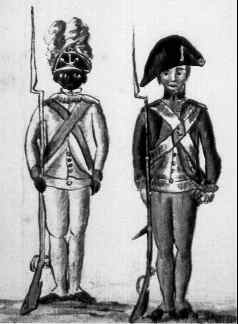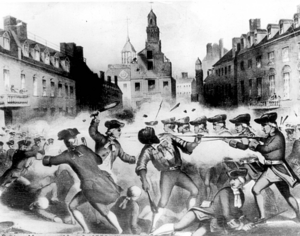African Americans in the Revolutionary War facts for kids
During the American Revolution, approximately 20,000 African Americans joined the British side and became known as Black Loyalists. 9,000 joined the American side and were called Black Patriots. Some of these were freemen and some were slaves who had been promised their freedom.
Contents
African-American Patriots
Many free African Americans believed that the colonies should be free from England's controlling rule. They became known as the Black Patriots. One of the most famous of these was Crispus Attucks. He is believed to be the first person that was killed at the Boston Massacre. Some black men had already enlisted as Minutemen at this time. Minutemen were to be called upon if the British troops who were stationed in Boston began attacking the colonies. Both free and enslaved Africans had served in private militias that defended themselves against attacks by Native Americans.
Black men fought with the American colonies' Patriot forces beginning with the Battles of Lexington and Concord, the very first battle of the Revolutionary War. Other famous battles in which African-American soldiers fought include the Battle of Bunker Hill, Tyron's Raid, and the Siege of Yorktown.
African-American Loyalists
A total of approximately 20,000 Africans fought for the British army. Most of the men did not fight when the British army was fighting in the North. However, when manpower was low, the loyalists used Black men to fight for the British in the South - in Savannah, Augusta, and Charleston.
Lord Dunmore, who was the royal (British) governor of Virginia, promised freedom for slaves who were willing to fight for Britain. The slaves that joined the British side had "Liberty to Slaves" sewn onto their uniforms and became known as Black Loyalists.
African-American Sailors
Some African Americans signed on to serve in the navies. Even in the Southern colonies, where they were not in favor of putting guns into the hands of slaves, black men piloted and used the weapons on ships. Some African Americans even served as captains of the ships.
Black Regiment of Rhode Island
In 1778, Rhode Island was having trouble recruiting white soldiers and decided to try enlisting black men. The Rhode Island Assembly voted to allow it, and the 1st Rhode Island Regiment became the only regiment of the Continental Army to consist of mostly black soldiers.
Fate of Black Loyalists
After the last British ship left Savannah, 5,000 enslaved African Americans traveled with their Loyalist masters to Jamaica or St. Augustine. About 300 black people in Savannah did not leave because they were afraid that they would not have the freedom they were promised.
The British left Charleston a year later, taking more than 5,000 black men with them. More than half of them were enslaved by the Loyalists. Some were given land.
In the North, the British created book of people who had escaped slavery and called it the Book of Negroes. The book listed the details of their slavery, their escape, and their service to the British. If the British agreed that the former enslaved person had done enough for Britain, they were given a certificate giving them permission to travel out of New York. In this way, many black men, women, and children resettled in Nova Scotia, Canada.
About 200 formerly enslaved people were taken to London to live as free people. People in England who were in favor of black men being free made a colony in West Africa for them. Freetown was the first settlement established in what became the colony of Sierra Leone. Many from Canada moved to West Africa as well.
Fate of Black Patriots
The African American Patriots who served in the Continental Army did not receive rewards after the war. Many state legislatures banned all black people, free and enslaved, from military service. North Carolina was among the states that allowed free people of color (people of mixed African, European, and sometimes Native American descent) to serve in their militias and carry weapons. In 1792, the United States Congress stated that only "free able-bodied white male citizens" were allowed to serve in the military.
In 1789, free black men were allowed to vote in five of the thirteen states. This showed that they were considered citizens of both their states and the United States.
Many enslaved men who fought in the war gained their freedom. Some men's owners took back their promise of freedom and made the men be their slaves again.
Within the first twenty years after the American Revolution, the Northern states abolished (got rid of) slavery. By 1840, virtually all African Americans in the North were free. The South, however, held onto their "right" to own slaves until the ratification (approval) of the 13th Amendment to the United States Constitution in December of 1865.
Quick facts about African Americans in the Revolutionary War
- African-American men who fought for the American colonies were called Black Patriots.
- African-American men who fought for the British were called Black Loyalists.
- The 1st Rhode Island Regiment was made up of mostly black soldiers.
- Both Black Patriots and Black Loyalists were promised their freedom as a way to get them to fight in the war.
- After the war, some Patriots and Loyalists were able to gain their freedom and settle elsewhere. Others were taken back by their former masters, who broke their promises to set their slaves free as payment for fighting in the war.
- African Americans were no longer allowed to be slaves when the 13th Amendment to the United States Constitution was Ratification ratified in December of 1865.



